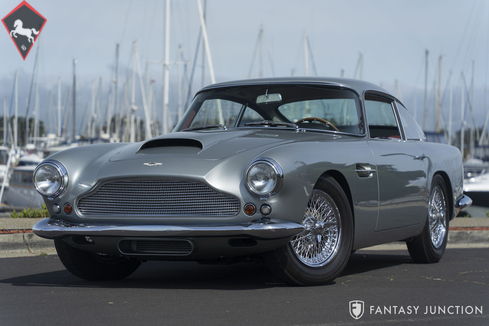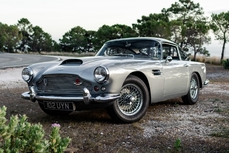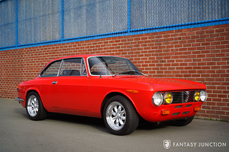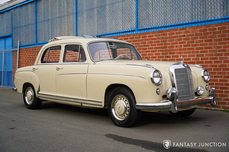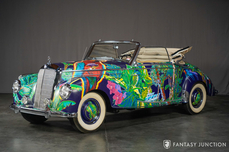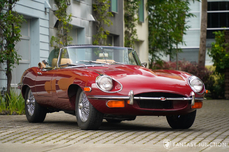Aston Martin DB4 3.7L DOHC Inline 6 Cylinder 1959
Allmän beskrivning :
1959 Aston Martin DB4 Series 1
s/n DB4/221/L, Engine no. 370/253
Silver with Red Leather
Aston Martin remains today as one of the finest performance cars built for racing or road use. Throughout their history, Aston Martin has produced truly amazing cars, serving both performance and elegance as the perfect combination of motoring sophistication that remains at the heart of the Aston Martin brand. Succeeding ahead of competitors with far greater resources, Aston Martin has delivered on their promise of performance and elegance, packaging a unique motoring experience that captures the hearts of sporting enthusiasts in search of excellence. When David Brown took the helm, his clever and timely purchase of Lagonda, secured the use of their sophisticated 2.6 liter twin-cam inline six-cylinder engine, designed by none other than W.O. Bentley. The heart of their first ventures into superb road going cars, by the late 1950s Aston Martin would establish a leadership role against many worthy competitors.
With continued success and sales growing, Aston Martin astutely retained the services of the finest Italian coachbuilders for both production cars and one-off show cars. The resultant improvements in the line were immediately evident through the seminal DB series cars, including the DB4, which used the patented Touring Superleggera (Super Light Weight) construction. These hand formed aluminum bodies, mounted over steel sub-structure, were lightweight, beautifully appointed, and offered top-tier performance. They also contributed greatly to establishing the definitive profile for elegant GT automobiles that would follow through the 1960s. The DB4 featured a newly designed 3.7-liter dual overhead cam engine designed by Polish race car driver Tadek Marek. This potent engine was mated to a 4-speed manual gearbox, while four-wheel Girling disc brakes handled stopping duty. Independent front suspension utilized ball-jointed wishbones, coil springs, and rack-and-pinion steering, while the live rear axle employed coil springs and a Watt’s linkage.
Period tests returned impressive results, once again placing Aston Martin at the top of their game in performance while delivering a uniquely conceived design. The Series 1 Touring body was clean, uncluttered with fussy trim, and the ventless side window profile created a pure and elegant statement which remains today one of the most revered and now iconic GT profiles from this prolific era.
This DB4 was purchased by a prominent international vintage sports car enthusiast around the year 2000. According to the current owner, the prior owner, an older Colombian gentleman, and his Swiss wife, discovered this DB4 in Switzerland. The couple intended to import it to their residence in Colombia. At that time, import restrictions were limiting entry into Colombia, so the owner imported the car into Colombia with paperwork and chassis number from a donor DB2, also in his ownership. The prior owner restamped this DB4 using the donor DB2 numbers, then reused his existing DB2 paperwork as a means for the DB4 entry into Colombia. An excellent candidate for restoration, the DB4 body had suffered typical electrolysis but was accompanied by a spare engine and gearbox. According to the current owner, after recognizing the importance of this Series 1 DB4, he engaged a visiting friend and employee of Aston Martin to assist in establishing and then reuniting the car with what is understood by the current owner to be the correct DB4 chassis number for this car. As part of the restoration under the care of Aston Engineering and with Aston Heritage support, the correct chassis number was approved by Aston Heritage, the plate issued, and both a frame stamped number and Aston plate were applied to the car.
During the restoration, the car was treated to expert alloy panel and steel frame handwork as shown in the restoration photos. To complete the car to a high standard, the entire drivetrain, suspension, brakes, electrical, the complete interior, and all glass was removed. The body shell remained in Colombia for specialized body and paint work while the mechanical features were crated and shipped to Aston Engineering in the UK to leverage their expertise in these areas. While the engine and gearbox were being rebuilt in the UK, refinishing for the bare alloy body shell was completed in Colombia using beautiful silver metallic paint accented by the installation of freshly reupholstered red leather interior, using leather and other specialized materials supplied by Aston Martin Heritage. According to the restoration documentation included with the car, in 2006 the owner visited Aston Engineering Ltd where the engine, transmission, rear axle, brakes, front suspension, steering, rear suspension, electrical and interior were all completed. While at Aston Engineering, the engine block and crankshaft were crack tested, machining performed on the engine, and a shallow sump installed. Aston Engineering rebuilt the engine, bored to 4.2-liter specifications, and provided dyno testing indicating 250hp at 5,000 rpm, which is noted in copies of the dyno sheets accompanying the car. At this time, the engine in the car was machined and stamped with a corresponding number that matched the engine number issued by Aston Martin Heritage as stamped on the chassis plate. The finished engine, gearbox, and mechanical features were crated and shipped from Aston Engineering, UK to Colombia for final assembly. As an added feature, electric overdrive was added to the car for improved highway driving. Copies of the restoration receipts reference a complete DB4 wiring loom, 9.5” clutch assembly, steering and wishbone bushings, and numerous hardware and trim parts, to name just a few of the many items restored or replaced on this car. Outside services included instrument restoration, while Aston Heritage materials for the interior include Mulberry leather, black leathercloth, ribbed floor mats, new door handles and escutcheons, red Wilton carpets, Hardura black boot covering, off white headliner, and black vinyl material. The restoration evolved over several years before completion in 2016, when the chassis plate currently on the car was supplied by Aston Martin Heritage and installed on the car. After the restoration was completed, the car arrived in North America for consignment.
Today this beautifully restored Aston Martin elegantly displays all the traits of a handsomely configured Series 1 DB4. The paint quality is of excellent quality with the exception of a paint prep flaw at the front of the passenger’s side cowl near the windshield. The color is very fitting for the alloy Touring coachwork offering one of the best colors to appreciate the elegance of this design. The finish is glossy throughout featuring correct metal flake mixed into the silver finish. The panel gaps are very well done with crisp closure on all strike surfaces and properly detailed inner panel surfaces. The exterior trim is very nice throughout including the beautifully finished Aston Martin grille and chrome plated front and rear bumpers, the latter of which shows light hazing to the topside finish. The body lines are beautifully resolved with excellent body contours and properly controlled reflections particularly in the tailored Touring wheel arches. The clean trunk line brilliantly tapers down while the bladed edges of the rear fender line terminate in elegantly stacked taillight lenses with delicate chrome trim.
The sweeping roofline and rear glass are very sophisticated for the era, while the chrome wire wheels with correct Michelin tires, and triple-ear knockoffs create a flash of competition history on this subtle and sophisticated Grand Touring design. The glass, exterior emblems, lighting, exterior lenses, and turn indicators are all in excellent condition.
Attention to detail, accuracy, and quality materials are equally evident throughout the interior of the car. The supple red leather seats are perfectly tailored with excellent pleat lines and perimeter seat piping as well as proper seat foam in the bolsters. The matching red door panels, red Wilton carpets, and handsomely finished rear seat area are beautifully presented. The painted dashboard finish contrasts elegantly with the delicate chrome accents highlighted by a wonderful array of restored instrumentation filling the driver’s binnacle. A large diameter wood steering wheel with painted spokes is the perfect partner for the floor mounted 4-speed shifter. Nestled beneath the climate control levers, the AM/FM radio and speaker grille finish the center area between the two seats. Overall, the interior delivers an exceptionally fine, authentic appearance including the trunk compartment, which is upholstered with black carpet, concealing a matching wire wheel spare tire nestled into the subfloor tire tub.
The beautifully restored twin-cam engine and engine compartment are presented with excellent finishes, proper fasteners, and period correct components thoughtfully prepared just as delivered when new. The cast alloy engine components are polished to an appropriate luster, not overdone as is often seen. The 4.2-liter engine, bored by Aston Martin Engineering during rebuild, is correctly outfitted with twin Solex carburetors, and a polished fan shroud. A set of correct metal identification plates are properly in place in the engine compartment. The engine bay and all hardware have been expertly refinished to a very high standard, prepared with originality and pride. The undercarriage has also been restored with high quality finishes and is indicative of very few miles driven since completion. The leather rear suspension retaining straps, stainless-steel exhaust system, correctly coated parts, and properly finished suspension components all contribute to a very cohesive restoration.
The driving experience is very satisfying with excellent shifting through the comfortable 4-speed gearbox, which has been thoughtfully updated with electric overdrive. Acceleration from the twin-cam engine, displacing 4.2-liters, is indeed rewarding, with throttle response that comfortably manages leisurely cruising or more spirited intentions, particularly on highway drives with the electric overdrive engaged. The Girling disc brakes operate in balance with the chassis, coming down smoothly and tracking evenly even from higher speeds.
Beautifully finished in iconic colors, this Aston Martin DB4 is ready to offer the next fortunate enthusiast all the joys associated with owning one of the finest examples of GT performance cars ever offered for road use. Powerful and elegant, this wonderful example combines all the traits of enjoyable motoring from a romantic and inspired era that can only be experienced from behind the wheel of a vintage Aston Martin.
Please note that this car is being sold duty paid in the United States on a cancelled Colombian title.
https://fantasyjunction.com/inventory/1959-aston-martin-db4-series-1/overview
1959 Aston Martin DB4 3.7L DOHC Inline 6 Cylinder is listed såld on ClassicDigest in Emeryville by Fantasy Junction for Ej prissatt.
Fakta i bilen
Karosstyp : Personbil Märke : Aston Martin Modell : DB4 Modellversion : 3.7L DOHC Inline 6 Cylinder Motorvolym : 3.7 Årsmodell : 1959 Läge : Emeryville Fordon Registrering : Normal
Såld
Information om säljaren
Såld
People who viewed this Aston Martin DB4 also viewed similar Aston Martin listed at ClassicDigest
Other cars listed for sale by this dealer
om Aston Martin DB4
Aston Martin DB4 är en ikonisk modell i Aston Martins historia, känd för sin eleganta design, prestanda och lyx. Här är en översikt över dess historia, specifikationer, produktionsnummer och kulturella sammanhang:1. Historik: Aston Martin DB4 introducerades 1958 som en ersättning för DB Mark III. Den designades av Carrozzeria Touring i Milano, Italien, och representerade ett betydande steg framåt för Aston Martin när det gäller prestanda och stil.
2. Specifikationer:
- Motor: DB4:an hade från början en 3,7-liters inline-sex-motor, som senare uppgraderades till en 4,0-litersmotor i senare modeller. Effekten varierade från cirka 240 till 266 hästkrafter, beroende på den specifika varianten.
- Växellåda: Den var utrustad med en 4-växlad manuell växellåda, och några senare modeller erbjöds med en 3-växlad automatisk växellåda som tillval.
- Prestanda: DB4 kunde uppnå en topphastighet på cirka 140 till 150 mph (225 till 240 km/h) och kunde accelerera från 0 till 60 mph (0 till 97 km/h) på cirka 8 sekunder.
3. Produktionsnummer: Produktionsnumren för Aston Martin DB4 är följande:
- Aston Martin DB4 (1958-1963): Cirka 1 113 enheter tillverkade i olika karossstilar och varianter.
4. Kulturellt sammanhang: Aston Martin DB4 representerade ett betydande steg framåt för Aston Martin när det gäller design och prestanda. Den visade upp en blandning av brittiskt hantverk och italiensk stil, med lätta konstruktionstekniker och eleganta linjer. DB4:ans lyxiga och sportiga karaktär gjorde den till ett önskvärt val för kräsna köpare, inklusive kändisar och entusiaster.
DB4:ans framgångar på vägen och dess deltagande i motorsportevenemang stärkte dess rykte ytterligare. Det tävlade i olika racing- och rallyevenemang och nådde anmärkningsvärda framgångar, inklusive klassvinster och totalsegrar i lopp som Le Mans 24 timmar och RAC Tourist Trophy.
Aston Martin DB4 är fortfarande en ikonisk och mycket eftertraktad klassisk bil idag. Dess tidlösa design, kraftfulla prestanda och koppling till Aston Martins arv har gjort den till en symbol för fordonsexpertis och önskvärdhet. Samlare och entusiaster värdesätter DB4 för dess raritet, hantverk och historiska betydelse inom Aston Martin-serien.
"Superleggera" är en italiensk term som betyder "superlätt" eller "superlätt". Det är ofta förknippat med karossbyggarföretaget Carrozzeria Touring Superleggera, som har varit känt för sina lätta konstruktionstekniker som används vid skapandet av olika ikoniska bilar.
Carrozzeria Touring Superleggera är krediterad för att popularisera superleggera-konstruktionsmetoden, som innebar att man använde ett lätt ramverk av stålrör med liten diameter täckta med handformade aluminiumpaneler. Denna konstruktionsteknik minskade fordonets totala vikt samtidigt som den strukturella integriteten bibehölls.
Termen "Superleggera" har också använts av flera biltillverkare, inklusive Aston Martin, Lamborghini och andra, för att beteckna speciella lätta eller högpresterande versioner av deras fordon. Dessa fordon har ofta viktminskningsåtgärder, aerodynamiska förbättringar och ökad effekt för att leverera förbättrad prestanda och kördynamik.
Till exempel har Aston Martin använt "Superleggera"-beteckningen på modeller som Aston Martin DBS Superleggera, som representerar det ultimata uttrycket för prestanda och lyx i Aston Martin-sortimentet. Dessa fordon har vanligtvis kraftfulla motorer, avancerad aerodynamik och omfattande användning av lättviktsmaterial för att uppnå en perfekt balans mellan prestanda och lyx.
Sammanfattningsvis hänvisar "Superleggera" till konceptet lättviktskonstruktion och har förknippats med både Carrozzeria Touring Superleggera coachbuilder och specifika högpresterande modeller från olika biltillverkare. Det representerar en strävan efter viktminskning och förbättrad prestanda utan att kompromissa med stil och lyx.
